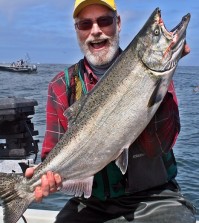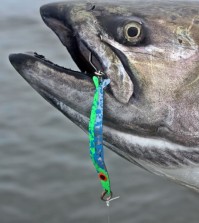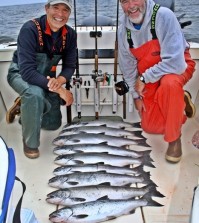Six Tricks for Fall Coho

As summer gives way to fall here in the Pacific Northwest, the dependable Coho that used to bite so well when they were out and in open water often get harder and harder to catch. Anglers are in general agreement that the good ol’ Coho can sometimes be the most cooperative fish in the sea, even suicidal in its efforts to gulp anything with a hook attached. Unfortunately, that user-friendly attitude tends to disappear, as mature silvers get closer to the gravel beds, hatchery ponds or net pens where their lives began.
As spawning time approaches, mature silvers become a whole lot less interested in food, and anglers may have to dig deeper into their bag of tricks to keep catching them. Here are a handful of little gimmicks tricks you may try if you want to continue catching mature Coho from our inshore waterways and estuaries this fall.
1. GET SNEAKY
Coho tend to get more and more paranoid about baits and lures as they run out of vertical space. Even though they may live most of their natural lives in the top 20 feet of the water column, they get increasingly spooky when the water depth is only 20 feet from top to bottom, and their typical recklessness gives way to some instinctive fear of everything having to do with those of us holding fishing rods.
Boats seem to have a significant impact on a fall Coho’s sense of security, so try to avoid running over them as you fish. If, for example, trolling is your thing, fish a much longer line than you would earlier in the season; giving wary fish more time to settle down after your boat passes by. It’s a given that hooking and landing a wildly jumping Coho is more difficult when you’re fishing 150 yards behind the boat than when you’re fishing only 50 yards of line, but that longer line just may be the difference between hooking and not hooking fish in the first place.
If you’re a boat fisherman who likes to cast spoons, spinners or jigs for your fish, consider using a longer rod and lighter line to increase your casting distance. Getting that lure a few yards farther from the boat may spell the difference between success and failure. Better yet, if you can do so safely and without trespassing, beach the boat and cast from shore. Strange as it may seem, simply getting the boat out of the water and walking up the beach a few yards has paid off for me on several occasions.
I have a friend who takes the sneaky thing farther than most, and I’ve seen the results. He fishes in camouflage, stays back several feet from the water and keeps as low a profile as possible while casting for wary silvers. As you might guess, his favorite fishing days are the cloudy, rainy and windy ones, when the water’s surface is choppy and visibility is low.
2. TEASE ‘EM INTO STRIKING
Waiting for “the bite” to occur with fall Coho could result in a very long wait, so you’ll probably have to do something to provoke them into striking.
As a general rule, smaller baits and lures work better than larger offerings, since these fish are no longer into filling their stomachs. Two or three-inch plug-cut baits or cut spinners work a lot better than the four or five-inch stuff that produces during summer. Try to keep both the baits action and the trolling pattern as erratic as possible by speeding up, slowing down, lifting and dropping the rod tip and changing direction frequently. All of these things may provoke Coho strikes when a routine, rhythmic bait action won’t.
This is the time of year when artificials become a very important part of the Coho angler’s arsenal, especially weighted spinners and horizontally fished metal jigs. The flash of a smoothly revolving spinner blade can be irresistible to a mature silver, especially if you vary the retrieve speed and experiment to find the size, style and finish they happen to want that day. I’ve had days when they’ve hit nothing but a Vibrax with a silver blade and blue body on one beach, then moved a few hundred yards to another beach where the only thing they’d take was a quarter-ounce Bang-Tail in a black scale finish.
3. TRY HORIZONTAL JIGGING
The metal jigs that catch salmon when you fish ’em up and down through the water column also are effective when worked near the surface in a lift-drop-retrieve technique that I like to call “horizontal jigging.” The time-proven Buzz Bomb (see related article on this site) is the traditional lure of choice for this kind of fishing, and certainly one of the best, but it’s not the only one you can use effectively. Any of the baitfish-imitating jigs (in smaller sizes and lighter weights so they don’t sink too quickly) will entice fall silvers from their shallow-water environs.
The horizontal jigging technique is simple as long as you remember that a free-falling jig is the key to success. Cast as far as you can, allow the jig to drop several feet, and then retrieve it in a series of lifts and drops. Retrieve line on the lift, and then drop the rod tip sharply, allowing the lure to sink two to four feet on a slack line. Jigs draw strikes when they’re falling, and they won’t fall freely on a tight line, so the quick and pronounced drop is the most important part of the jigging stroke. If your jig of choice is a Buzz Bomb or one of the other free-sliding styles, remember to use the rubber doughnut or some other soft bumper between the lure and the hook to help prevent knot damage when using light line for longer casts. And, whatever jig you use, keep the hook point needle-sharp.
4. FISH HARD DURING THE FLOOD
When your schedule allows, concentrate much of your fishing effort during the flood tide. Fall silvers tend to be more active and sometimes more eager to take baits and lures as the water rises. It’s especially true if you’re looking for silvers in the shallow estuaries and small bays of central and south Puget Sound, but often applies as well in the deeper, more open waters of the north Sound and eastern Strait of Juan de Fuca. My idea of a perfect day to prospect for fall fish is a day when I can launch on a low slack at daylight and fish an incoming tide the first few hours of the morning.
5. SCRATCH THE SURFACE
Skipping a fly along the water’s surface is a time-proven Coho-catching technique in the waters around Neah Bay, but few Coho anglers ever resort to fishing surface lures anywhere else in the Northwest. Well, it’s worked for me a few times, and I recommend it when all else fails. There are times when Coho will accept-maybe even prefer-a lure fished right on the surface. It’s a trick that salmon anglers might keep in mind this time of year, when mature Coho congregate in our estuaries, often jumping and rolling on the surface as if to taunt us, while refusing to touch all the usual salmon baits and lures fished in all the usual ways.
The idea is to fish something that makes a wake, stops and goes, sputters, gurgles, bubbles, pops, or otherwise creates a surface disturbance that will draw the attention of silvers that are at or near the top of the water column. If you can get them to notice something they aren’t used to seeing, you just might trigger that instinctive strike response. Remember, these are goofy, unpredictable, close-to-spawning Coho we’re talking about, so an unusual lure presented in an unusual way will at times be just what the doctor ordered.
I like “minnow baits,” such as the well-known Rapala and similar lures, and some of the cupped-face ones known to freshwater bass anglers as chuggers and poppers, for this kind of top-water salmon fishing. I fish both types of plug the same way, pulling them to me in one- to three-foot surges. Constantly change the retrieve by taking longer and shorter swipes of the rod, some subtle and some more violent, and varying the length of time the lure rests on the surface between yanks from a second or two to as long as 10 or 15 seconds.
6. KEEP MOVING AND KEEP SEARCHING
Coho are on the move this time of year; so don’t spend a lot of time fishing where they may have been yesterday or last week. Stay on the move until you find fish. There’s a better-than-even chance that yesterday’s productive spot won’t be productive today, and you may have to prospect for new places to fish every day. Keep in mind that new runs of fish are moving in from the Pacific all the time, so remember to prospect farther “inside” for fish that that have passed by, and “outside” for fish that are still headed your way. Being mobile, of course, is much easier for boat anglers, but shore and dock fishermen also should have several options in mind with each new day of salmon fishing.
And, while you’re moving, keep an eye peeled for signs of Coho activity. Whenever I’m fishing for silvers I’m watching the surface for birds (especially Bonaparte gulls), bait, and jumping or boiling fish. I know some people like to believe that jumping Coho aren’t biters, but that’s really just a handy excuse for not being able to catch them. When I see Coho jumping-especially when there are lots of them jumping in shallow water-I fish ’em until I figure out what they’ll hit or until they quit jumping and go away.










